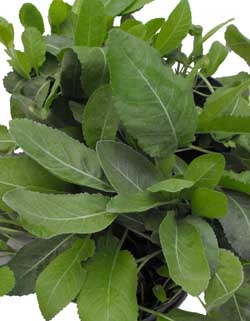New Account | Seed Mix |
Gift Certificates |AAS Winners |
Gardening Products
SEEDS: Unusual | Annuals | Perennials | Vegetables | Herbs | Trees
Costmary Seeds
Costmary has a pleasant balsam-like fragrance and though it was once used medicinally it is now rarely found in the garden or apothecary of modern herbalists. Costmary does have mild astringent properties making it a good addition to ointments, scented potpourri, and herbal baths. Costmary is an herb of many names. Its principal common name shows it to be an herb dedicated to the Virgin Mary. The alternate name, sweet Mary, likely refers to the Virgin Mary, too, or it could refer to Mary Magdalene: the early herbalists Gerard and Culpeper mentioned an herb called maudlin (Magdalene) which was identical or very similar to costmary. Other common names for costmary allude to its uses. As a flavoring of ales and spiced wine, it was called alecost. The name allspice applied to this herb may be a variant spelling for ale-spice, or perhaps the herb’s scent reminded someone of the spice allspice. Sweet tongue, a common name in Maine, refers to both the taste and the shape of the leaves.
For much of history, people have used costmary for its fragrance. It has been deemed useful for everything from washing linens to giving ale a sweet smell, which is how it got the name alecost. The nickname Bible leaf comes from the practice of churchgoers using leaves of the herb as Bible bookmarks. The herb was said to discourage silverfish. Supposedly, drowsy churchgoers would also sniff the leaf or chew it during long services and the strong smell/flavor kept them awake.
Useful gardening information
Costmary plants enjoy full sunlight exposure. They will tolerate partial shade, but blooming is significantly lower in shaded locations. Costmary is not particular about the soil it is grown in. It will adapt to and thrive in any medium, including dry soils, clay or sand soils, and even depleted soils. Costmary grows well in an herb garden with short herb plants which won’t block out the sunlight that it needs to thrive, such as sage, thyme, and oregano.
Sow in early spring, placing seeds on the surface of the soil of pots or flat or prepared garden bed and press in. Next gently water the seeds in, keeping everything evenly moist and in the light until germination. Germination can take 1 to 4 weeks. Space plants out 1 to 2 feet apart.

SF393 Costmary ( Tanacetum balsamita )
(Bible leaf) An old fashioned herb that has history of use dating back to biblical times, where it was believed to have been used by Mary to wash Jesus feet, leading to its common name. Also known as Bibleleaf from the practice of churchgoers using leaves of the herb as Bible bookmarks. The herb was said to discourage silverfish. Supposedly, drowsy churchgoers would also sniff the leaf or chew it during long services and the strong smell/flavor kept them awake.
Was once popular in Victorian times, found in nearly every kitchen garden, and for good reason! A versatile herb that offers a minty-eucalyptus like tang when used fresh in salads, sauces and soups. Highly aromatic, so use sparingly or else it will be overpowering! Can be brewed into a tea to ease pain and digestive discomfort. Medicinally recognized for its antibacterial, antifungal and insecticidal properties. Makes a great perennial border with soft grey green foliage and clusters of tiny bright yellow flowers. Plant in rich soil in full sun as it will become leggy and refrain from blooming in the shade. Height 2-4 feet.
Was once popular in Victorian times, found in nearly every kitchen garden, and for good reason! A versatile herb that offers a minty-eucalyptus like tang when used fresh in salads, sauces and soups. Highly aromatic, so use sparingly or else it will be overpowering! Can be brewed into a tea to ease pain and digestive discomfort. Medicinally recognized for its antibacterial, antifungal and insecticidal properties. Makes a great perennial border with soft grey green foliage and clusters of tiny bright yellow flowers. Plant in rich soil in full sun as it will become leggy and refrain from blooming in the shade. Height 2-4 feet.
Share a growing tip and help other gardeners!
Click on the Contact Form link, place "Tip" in the name line and fill in your information. If we accept your Costmary growing tip, we will post it on this page.
